Inversion of Initial Field Based on a Temperature Transport Adjoint
Abstract
1. Introduction
2. Models and Method
2.1. Forward Model
2.2. Adjoint Model
3. Materials and Parameters
3.1. Data
3.2. Model Setting
3.3. The Process of Inversion
- (1)
- Set a temperature background temperature distribution according to the computational domain and time;
- (2)
- Input the background temperature field into the forward model to obtain the numerical simulation results;
- (3)
- Calculate the cost function by the difference between simulation and observations;
- (4)
- Run the adjoint model by the difference between simulation and observations;
- (5)
- The gradient of the cost function with respect to the control variable is calculated by the adjoint equation;
- (6)
- The values are adjusted to get a new temperature field;
- (7)
- Repeat steps (2) to (6) until the error reduces to a steady state or reaches the preset maximum number of inversion steps, and the inversion ends.
4. Numerical Experiments
4.1. Ideal Experiment
4.2. Practical Experiment
5. Conclusions and Discussion
Author Contributions
Funding
Acknowledgments
Conflicts of Interest
References
- Kawai, Y.; Wada, A. Diurnal sea surface temperature variation and its impact on the atmosphere and ocean: A review. J. Oceanogr. 2007, 63, 721–744. [Google Scholar] [CrossRef]
- Wu, Z.; Huang, N.E.; Wallace, J.M.; Smoliak, B.V.; Chen, X. On the time-varying trend in global mean surface temperature. Clim. Dyn. 2011, 37, 759–773. [Google Scholar] [CrossRef]
- Lau, N.C. Interactions between Global SST Anomalies and the Midlatitude Atmospheric Circulation. Bull. Am. Meteorol. Soc. 1997, 78, 21–33. [Google Scholar] [CrossRef]
- Zhu, X.; Liu, Z. Tropical SST response to global warming in the twentieth century. J. Clim. 2009, 22, 1305–1312. [Google Scholar] [CrossRef][Green Version]
- Seager, R.; Zebiak, S.E.; Cane, M.A. A model of the tropical Pacific Sea surface temperature climatology. J. Geophys. Res. 1988, 93, 1265–1280. [Google Scholar] [CrossRef]
- Su, J.; Wang, H.; Yang, H.; Drange, H.; Gao, Y.; Bentsen, M. Role of the atmospheric and oceanic circulation in the tropical pacific SST changes. J. Clim. 2008, 21, 2019–2034. [Google Scholar] [CrossRef]
- Roxy, M.; Tanimoto, Y. Influence of sea surface temperature on the intraseasonal variability of the South China Sea summer monsoon. Clim. Dyn. 2012, 39, 1209–1218. [Google Scholar] [CrossRef]
- Sugimoto, S. Influence of SST anomalies on winter turbulent heat fluxes in the eastern Kuroshio-Oyashio confluence region. J. Clim. 2014, 27, 9349–9358. [Google Scholar] [CrossRef]
- Zhang, L.; Wu, L.; Lin, X.; Wu, D. Modes and mechanisms of sea surface temperature low-frequency variations over the coastal China seas. J. Geophys. Res. Ocean. 2010, 115, 1–13. [Google Scholar] [CrossRef]
- Yuan, J.; Wang, D.; Liu, C.; Wen, G. Validation of Microwave-Infrared, Tropical Rainfall Measuring Mission Microwave Im ager and Advanced Microwave Scanning Radiometer—Earth observing system and WindSat-derived sea surface temperatures in coastal waters of the northern South China Sea. Aquat. Ecosyst. Heal. Manag. 2016, 19, 260–269. [Google Scholar] [CrossRef]
- Ren, S.; Zhu, X.U.; Drevillon, A.; Wang, H.; Zhang, Y.; Zu, Z.; Li, A. Detection of SST fronts from a high-resolution model and its preliminary results in the south China sea. J. Atmos. Ocean. Technol. 2021, 38, 387–403. [Google Scholar] [CrossRef]
- Kawai, Y.; Kawamura, H.; Takahashi, S.; Hosoda, K.; Murakami, H.; Kachi, M.; Guan, L. Satellite-based high-resolution global optimum interpolation sea surface temperature data. J. Geophys. Res. Ocean. 2006, 111, 1–17. [Google Scholar] [CrossRef]
- Zhang, R.H.; Busalacchi, A.J.; Murtugudde, R.G. Improving SST anomaly simulations in a layer ocean model with an embedded entrainment temperature submodel. J. Clim. 2006, 19, 4638–4663. [Google Scholar] [CrossRef]
- Zhu, J.; Kumar, A.; Wang, H.; Huang, B. Sea surface temperature predictions in NCEP CFSv2 using a simple ocean initialization scheme. Mon. Weather Rev. 2015, 143, 3176–3191. [Google Scholar] [CrossRef]
- Peng, S.Q.; Xie, L. Effect of determining initial conditions by four-dimensional variational data assimilation on storm surge forecasting. Ocean Model. 2006, 14, 1–18. [Google Scholar] [CrossRef]
- Liu, X.; Wang, Q.; Mu, M. Optimal Initial Error Growth in the Prediction of the Kuroshio Large Meander Based on a High-resolution Regional Ocean Model. Adv. Atmos. Sci. 2018, 35, 1362–1372. [Google Scholar] [CrossRef]
- Kolmogoroff, A.N. The local structure of turbulence in incompressible viscous fluid for very large Reynolds numbers. C. R. Acad. Sci. URSS 1941, 30, 301–305. [Google Scholar]
- Wang, S.; Su, Y. A model for prediction SST in linited region-II. The model’s physical equation. Acta Oceanol. Sin. 1992, 11, 57–66. [Google Scholar]
- Zhang, W.G.; Wilkin, J.L.; Arango, H.G. Towards an integrated observation and modeling system in the New York Bight using variational methods. Part I: 4DVAR data assimilation. Ocean Model. 2010, 35, 119–133. [Google Scholar] [CrossRef]
- Song, Z.; Qiao, F.; Yang, Y.; Yuan, Y. An improvement of the too cold tongue in the tropical Pacific with the development of an ocean-wave-atmosphere coupled numerical model. Prog. Nat. Sci. 2007, 17, 576–583. [Google Scholar]
- Xu, Z.; Li, M.; Patricola, C.M.; Chang, P. Oceanic origin of southeast tropical Atlantic biases. Clim. Dyn. 2014, 43, 2915–2930. [Google Scholar] [CrossRef]
- Ohlmann, J.C.; Siegel, D.A. Ocean radiant heating. Part II: Parameterizing solar radiation transmission through the upper ocean. J. Phys. Oceanogr. 2000, 30, 1849–1865. [Google Scholar] [CrossRef]
- Riser, S.C.; Freeland, H.J.; Roemmich, D.; Wijffels, S.; Troisi, A.; Belbéoch, M.; Gilbert, D.; Xu, J.; Pouliquen, S.; Thresher, A.; et al. Fifteen years of ocean observations with the global Argo array. Nat. Clim. Chang. 2016, 6, 145–153. [Google Scholar] [CrossRef]
- Hosoda, S.; Ohira, T.; Nakamura, T. A Monthly mean dataset of global oceanic temperature and salinity derived from Argo float observations. JAMSTEC Rep. Res. Dev. 2008, 8, 47–59. [Google Scholar] [CrossRef]
- Zhou, C.; Ding, X.; Zhang, J.; Yang, J.; Ma, Q. An objective algorithm for reconstructing the three-dimensional ocean temperature field based on Argo profiles and SST data. Ocean Dyn. 2017, 67, 1523–1533. [Google Scholar] [CrossRef]
- Sasaki, Y. Some Basic Formalisms in Numerical Variational Analysis. Mon. Weather Rev. 1970, 98, 875–883. [Google Scholar] [CrossRef]
- Andreu-Burillo, I.; Holt, J.; Proctor, R.; Annan, J.D.; James, I.D.; Prandle, D. Assimilation of sea surface temperature in the POL Coastal Ocean Modelling System. J. Mar. Syst. 2007, 65, 27–40. [Google Scholar] [CrossRef]
- Peng, S.Q.; Xie, L.; Pietrafesa, L.J. Correcting the errors in the initial conditions and wind stress in storm surge simulation using an adjoint optimal technique. Ocean Model. 2007, 18, 175–193. [Google Scholar] [CrossRef]
- Zhu, X.; Zu, Z.; Ren, S.; Zhang, Y.; Zhang, M.; Wang, H. The improvements to the regional South China Sea Operational Oceanography Forecasting System. Ocean Sci. Discuss. 2020, 1–37. [Google Scholar] [CrossRef]
- Chen, D.; Busalacchi, A.J.; Rothstein, L.M. The roles of vertical mixing, solar radiation, and wind stress in a model simulation of the sea surface temperature seasonal cycle in the tropical Pacific Ocean. J. Geophys. Res. 1994, 99, 20345–20359. [Google Scholar] [CrossRef]
- Murtugudde, R.; Busalacchi, A.J. Interannual variability of the dynamics and thermodynamics of the tropical Indian Ocean. J. Clim. 1999, 12, 2300–2326. [Google Scholar] [CrossRef]
- Fan, W.; Lv, X. Data assimilation in a simple marine ecosystem model based on spatial biological parameterizations. Ecol. Modell. 2009, 220, 1997–2008. [Google Scholar] [CrossRef]
- Zhang, J.; Lu, X.; Wang, P.; Wang, Y.P. Study on linear and nonlinear bottom friction parameterizations for regional tidal models using data assimilation. Cont. Shelf Res. 2011, 31, 555–573. [Google Scholar] [CrossRef]
- Wang, C.; Li, X.; Lv, X. Numerical study on initial field of pollution in the Bohai Sea with an adjoint method. Math. Probl. Eng. 2013, 2013. [Google Scholar] [CrossRef]
- Wang, D.; Cao, A.; Zhang, J.; Fan, D.; Liu, Y.; Zhang, Y. A three-dimensional cohesive sediment transport model with data assimilation: Model development, sensitivity analysis and parameter estimation. Estuar. Coast. Shelf Sci. 2018, 206, 87–100. [Google Scholar] [CrossRef]
- Liu, Y.; Yu, J.; Shen, Y.; Lv, X. A modified interpolation method for surface total nitrogen in the Bohai Sea. J. Atmos. Ocean. Technol. 2016, 33, 1509–1517. [Google Scholar] [CrossRef]
- Zong, X.; Xu, M.; Xu, J.; Lv, X. Improvement of the ocean pollutant transport model by using the surface spline interpolation. Tellus, Ser. A Dyn. Meteorol. Oceanogr. 2018, 70, 1–13. [Google Scholar] [CrossRef]
- Zheng, Q.; Li, X.; Lv, X. Application of dynamically constrained interpolation methodology to the surface nitrogen concentration in the bohai sea. Int. J. Environ. Res. Public Health 2019, 16, 2400. [Google Scholar] [CrossRef]
- Li, X.; Zheng, Q.; Lv, X. Application of the spline interpolation in simulating the distribution of phytoplankton in a marine npzd type ecosystem model. Int. J. Environ. Res. Public Health 2019, 16, 2664. [Google Scholar] [CrossRef]
- Wang, C.; Lan, J.; Wang, G. Climatology and seasonal variability of theMindanao Undercurrent based on OFES data. Acta Oceanol. Sin. 2013, 32, 14–20. [Google Scholar] [CrossRef]
- Tomita, H.; Hihara, T.; Kako, S.; Kubota, M.; Kutsuwada, K. An introduction to J-OFURO3, a third-generation Japanese ocean flux data set using remote-sensing observations. J. Oceanogr. 2019, 75, 171–194. [Google Scholar] [CrossRef]
- Locarnini, R.; Mishonov, A.; Baranova, O.; Boyer, T.; Zweng, M.; Garcia, H.; Reagan, J.; Seidov, D.; Weathers, K.; Paver, C.; et al. World Ocean Atlas 2018, Volume 1: Temperature; U.S. Department of Commerce: Washington, DC, USA, 2019.
- Ullman, D.; Wilson, R. Model parameter estimation from data assimilation modeling: Temporal and spatial variability of the bottom drag coefficient. J. Geophys. Res. 1998, 103, 5531–5549. [Google Scholar] [CrossRef]
- Lu, X.; Zhang, J. Numerical study on spatially varying bottom friction coefficient of a 2D tidal model with adjoint method. Cont. Shelf Res. 2006, 26, 1905–1923. [Google Scholar] [CrossRef]
- Levitus, S.; Antonov, J.I.; Boyer, T.P.; Locarnini, R.A.; Garcia, H.E.; Mishonov, A.V. Global ocean heat content 1955–2008 in light of recently revealed instrumentation problems. Geophys. Res. Lett. 2009, 36, 1–6. [Google Scholar] [CrossRef]
- Huang, C.; Wu, M.; Huang, X.; Cao, J.; He, J.; Chen, C.; Zhai, G.; Deng, K.; Lu, X. Reconstruction and evaluation of the full-depth sound speed profile with world ocean atlas 2018 for the hydrographic surveying in the deep sea waters. Appl. Ocean Res. 2020, 101, 102201. [Google Scholar] [CrossRef]
- Shu, Y.; Zhu, J.; Wang, D.; Yan, C.; Xiao, X. Performance of four sea surface temperature assimilation schemes in the South China Sea. Cont. Shelf Res. 2009, 29, 1489–1501. [Google Scholar] [CrossRef]
- Yu, Y.; Zhang, H.R.; Jin, J.; Wang, Y. Trends of sea surface temperature and sea surface temperature fronts in the South China Sea during 2003–2017. Acta Oceanol. Sin. 2019, 38, 106–115. [Google Scholar] [CrossRef]
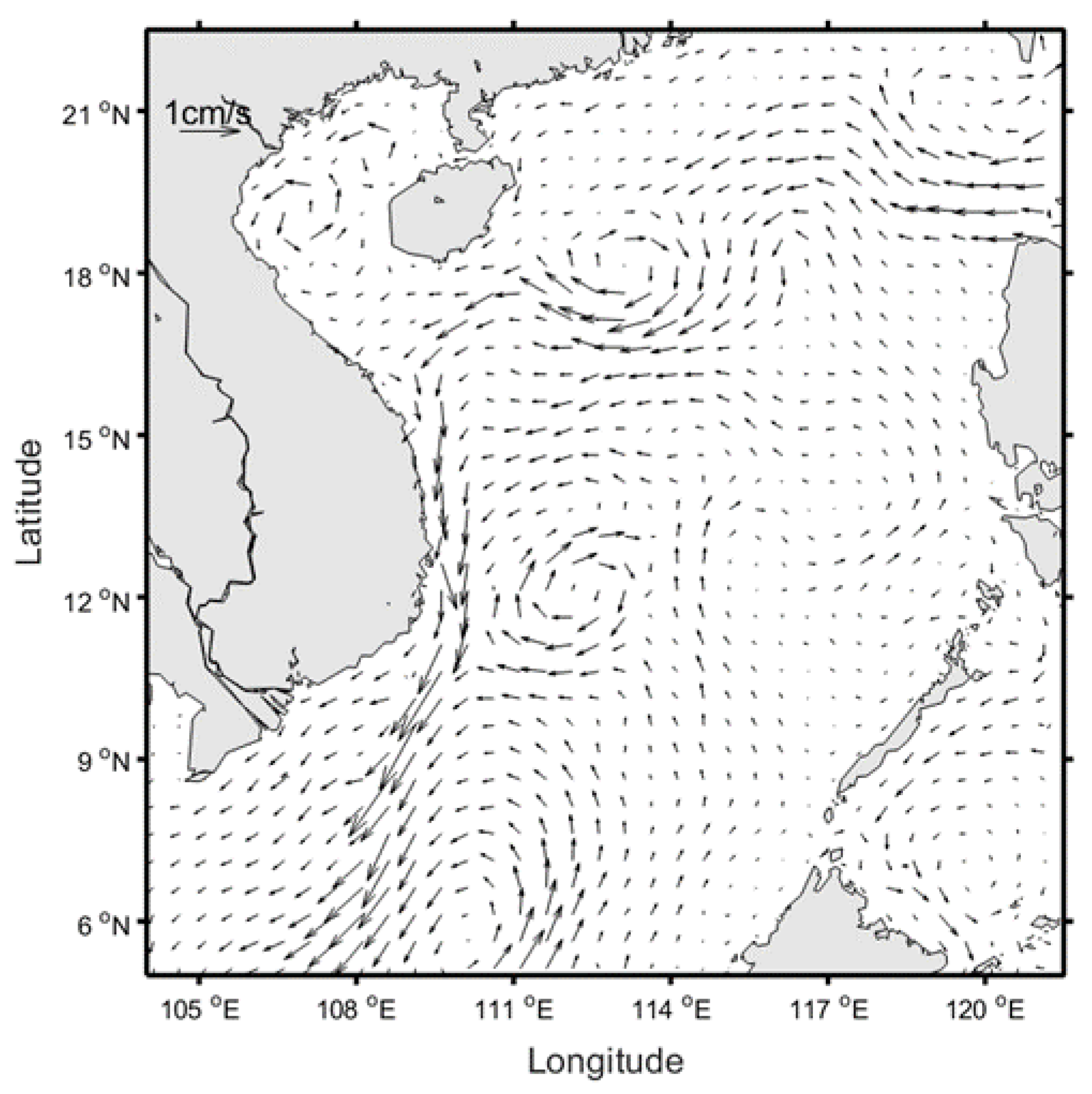
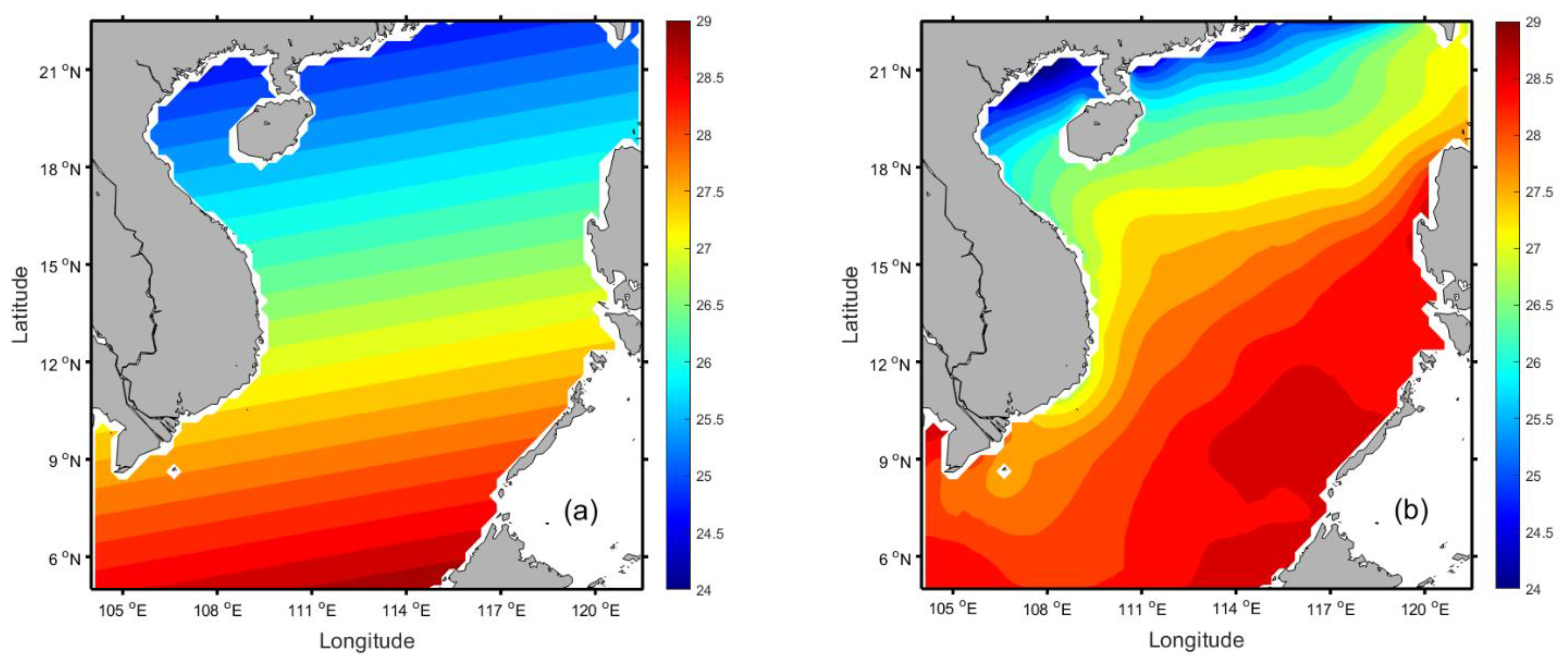
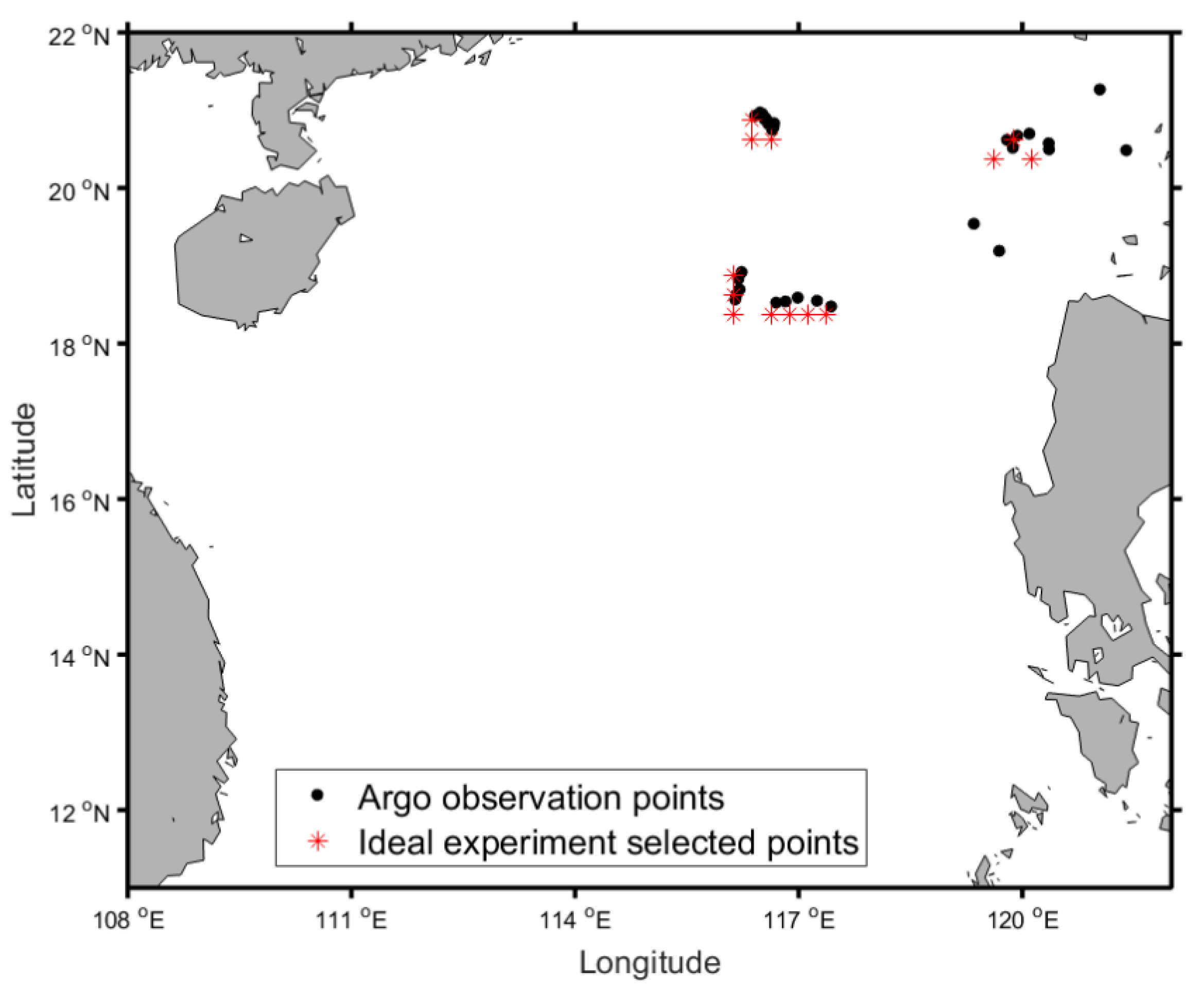
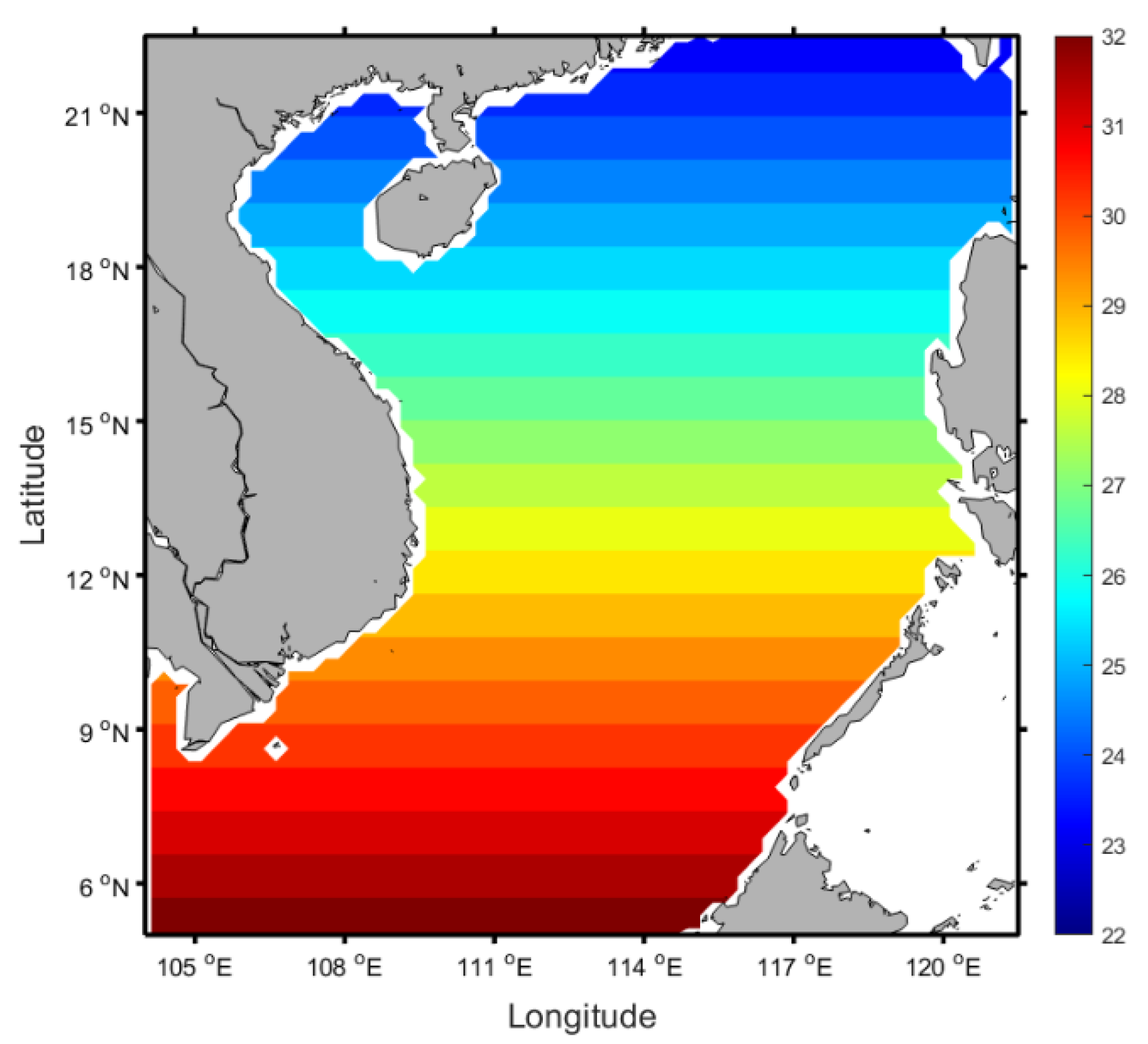
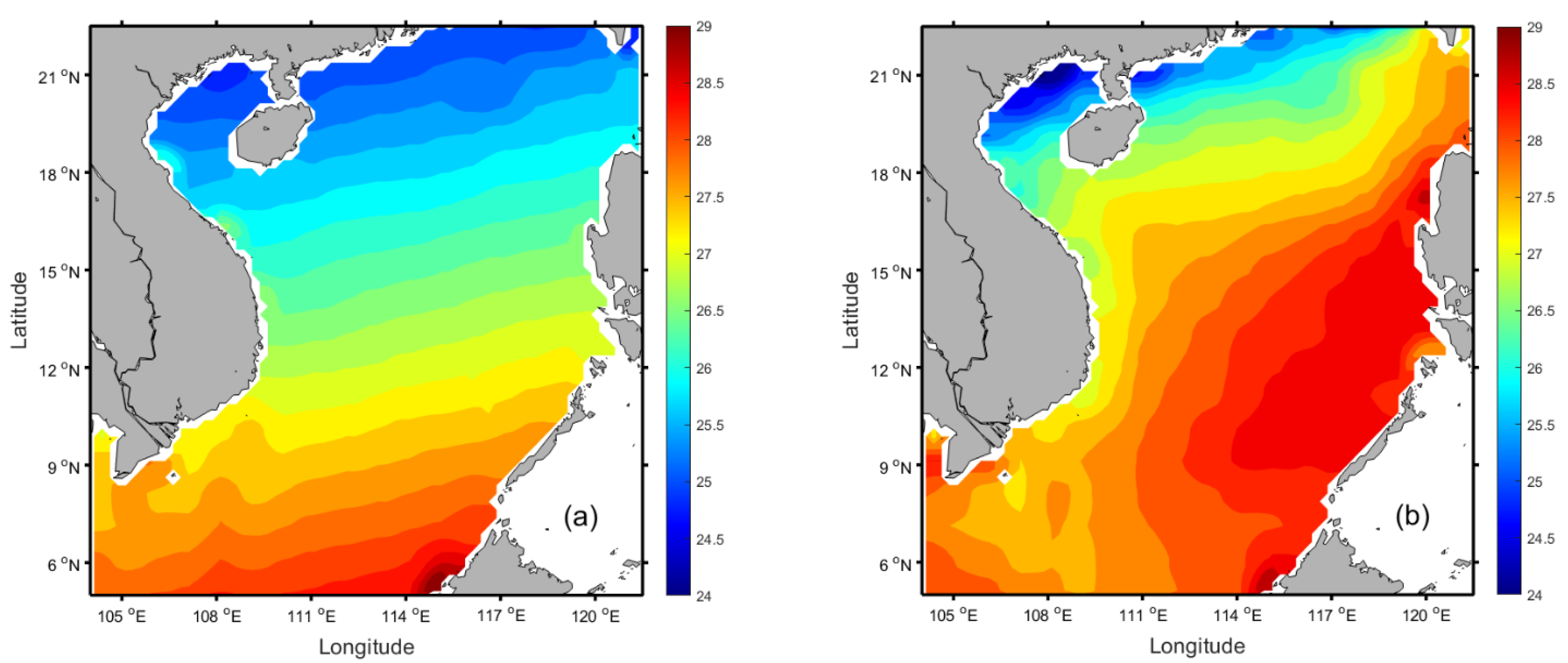
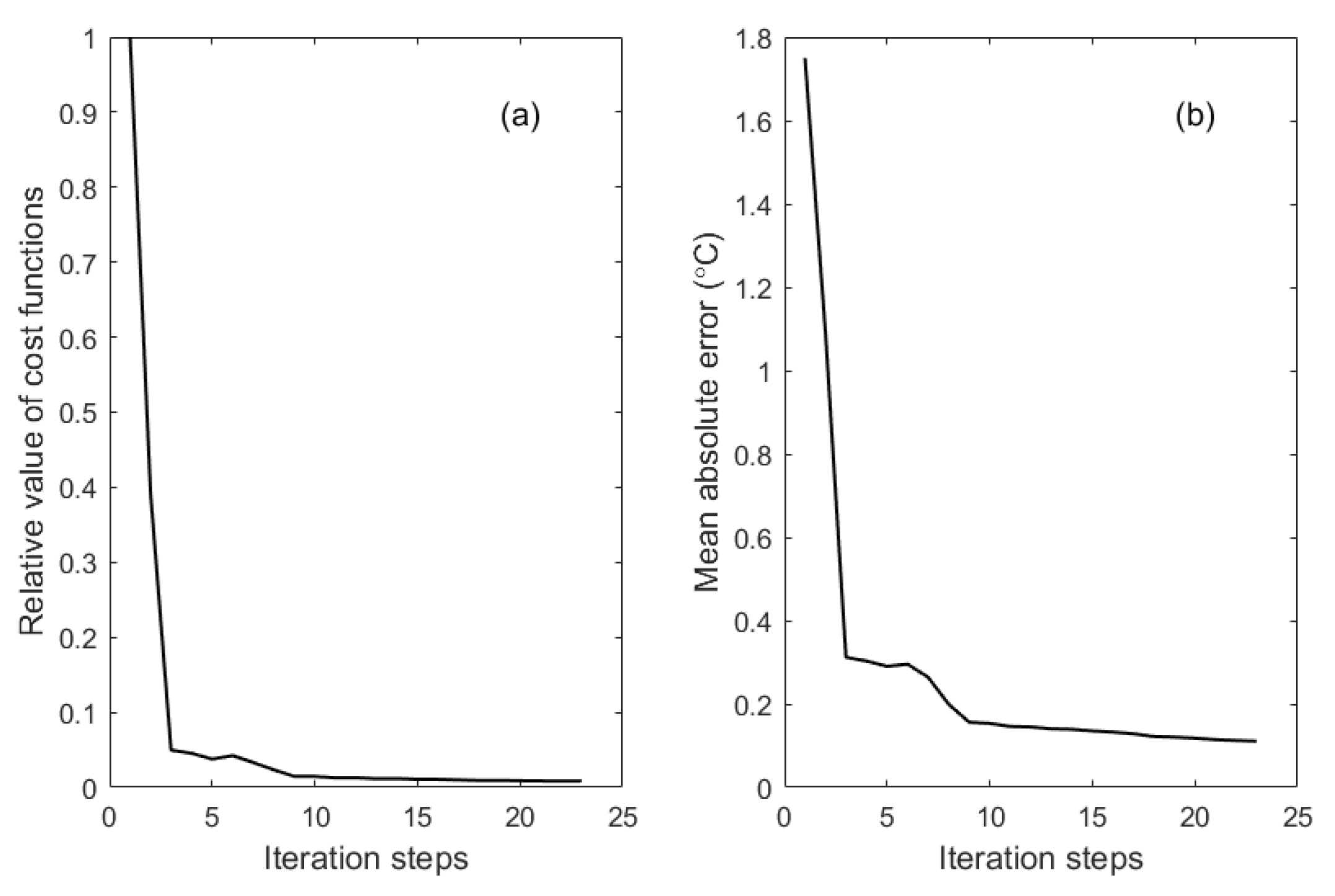
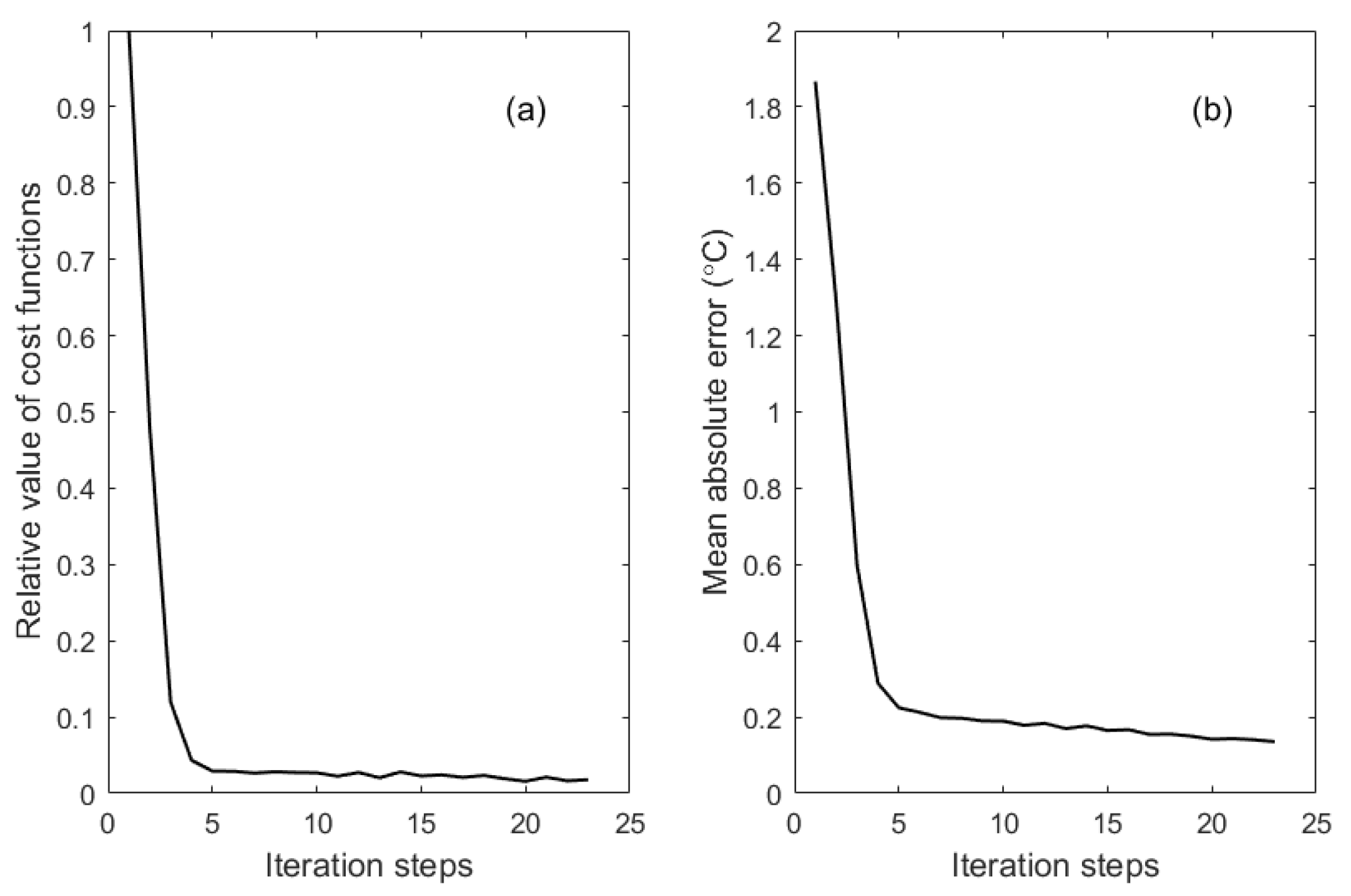
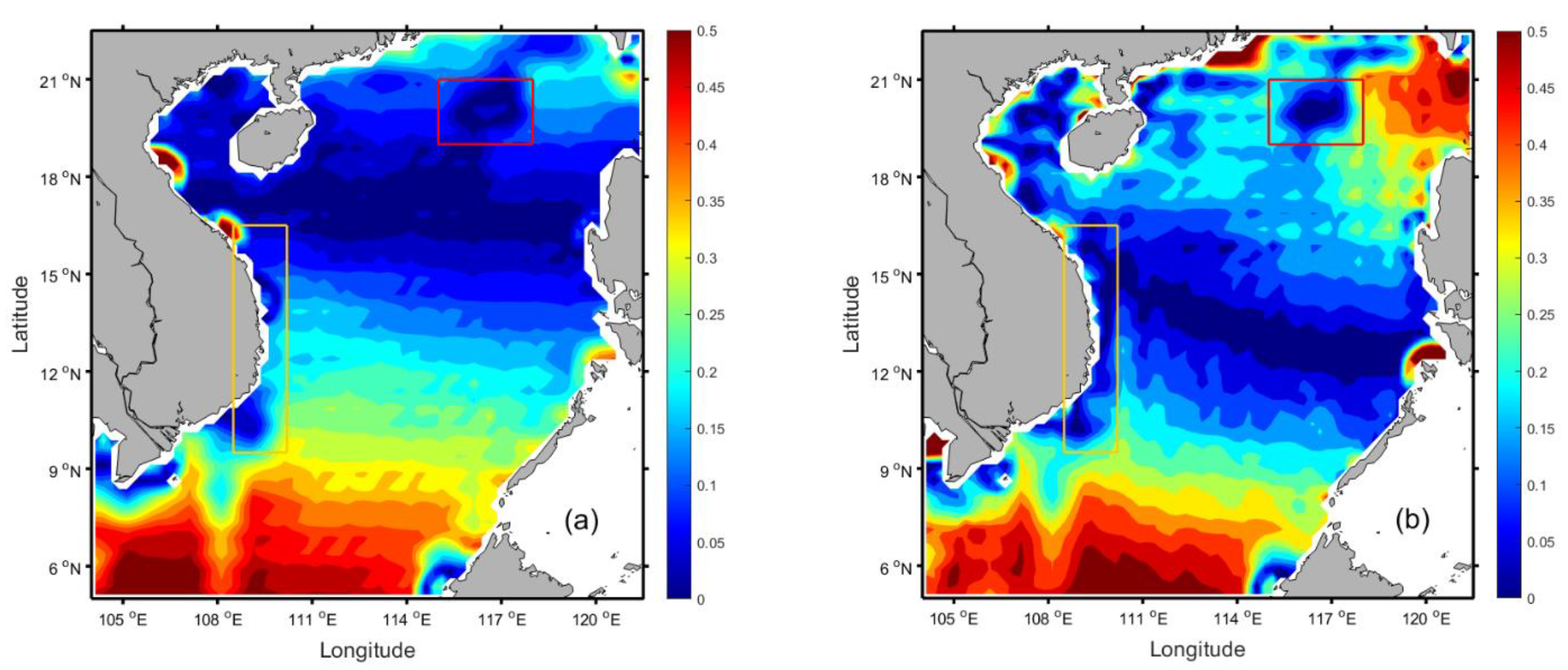
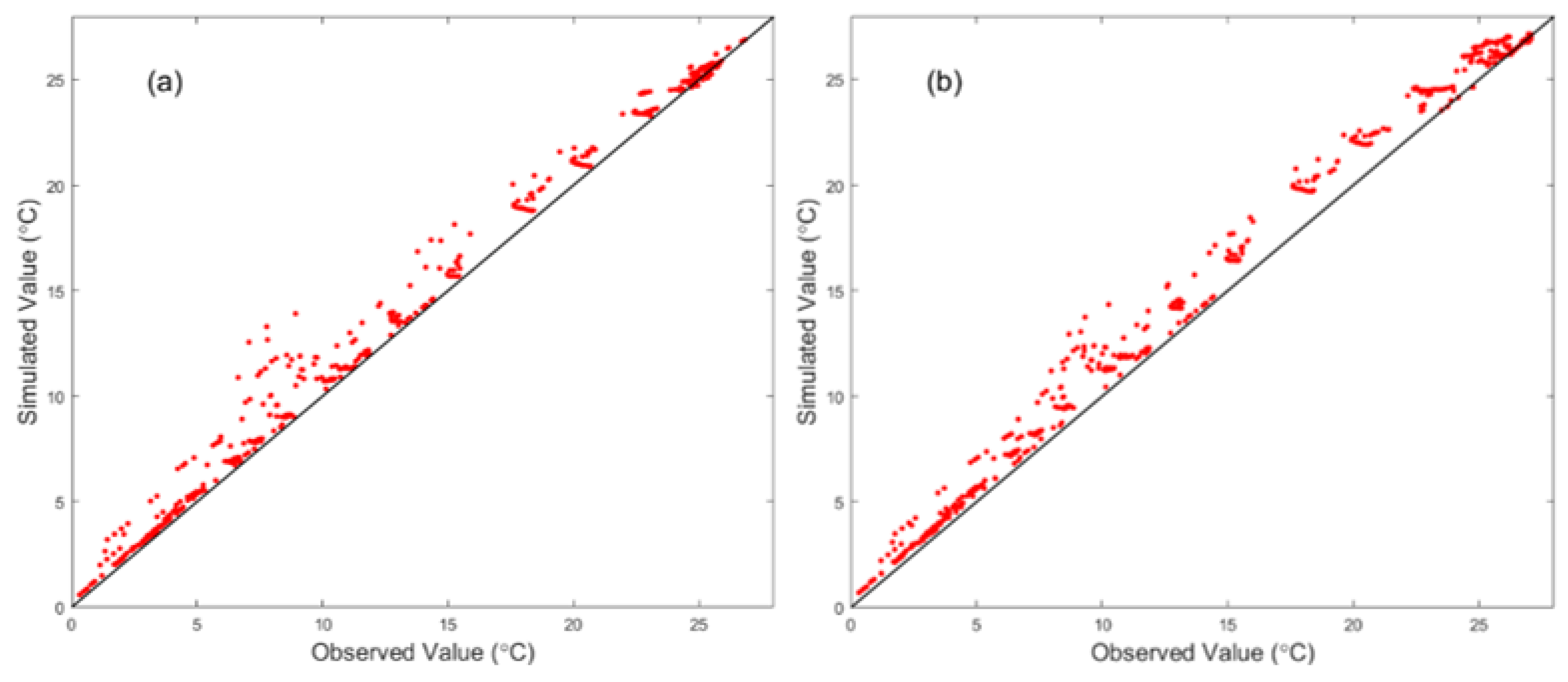
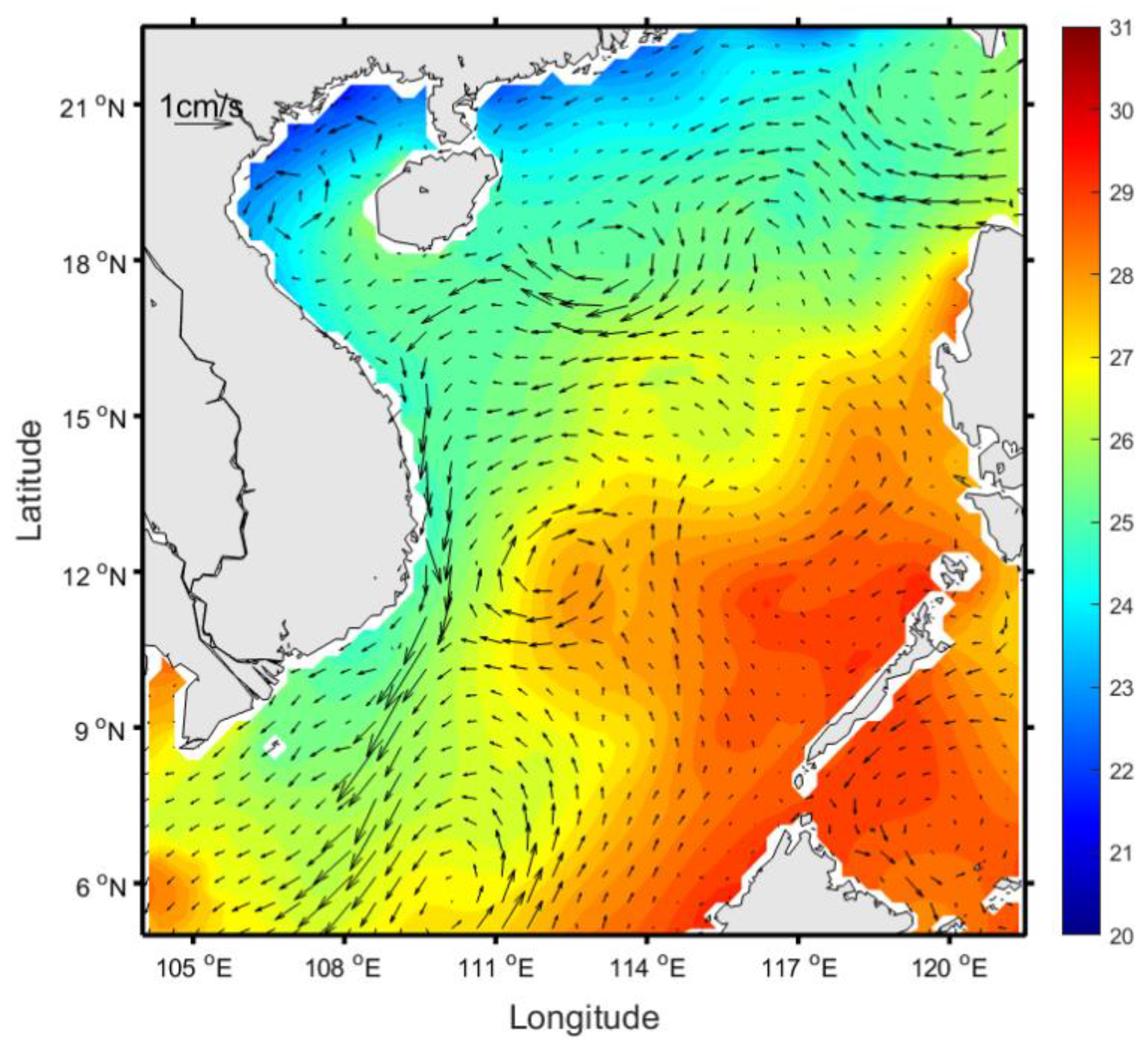

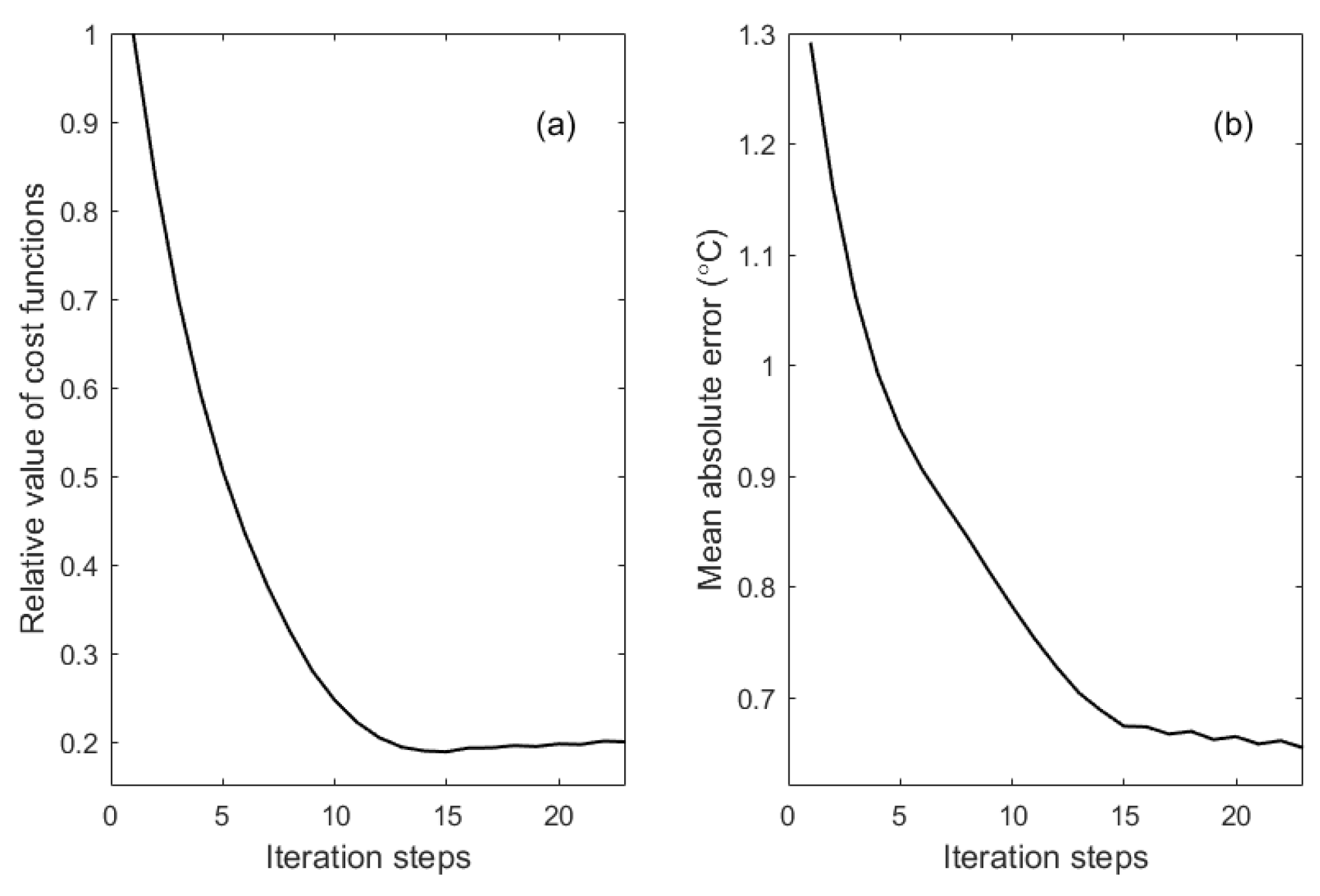
| Experiment | MAE (°C) | RMSE (°C) | ||
|---|---|---|---|---|
| Initial | Final | Initial | Final | |
| I | 1.83 | 0.19 | 2.20 | 0.22 |
| II | 1.94 | 0.24 | 2.33 | 0.37 |
Publisher’s Note: MDPI stays neutral with regard to jurisdictional claims in published maps and institutional affiliations. |
© 2021 by the authors. Licensee MDPI, Basel, Switzerland. This article is an open access article distributed under the terms and conditions of the Creative Commons Attribution (CC BY) license (https://creativecommons.org/licenses/by/4.0/).
Share and Cite
Jiao, S.; Huang, S.; Wang, J.; Lv, X. Inversion of Initial Field Based on a Temperature Transport Adjoint. J. Mar. Sci. Eng. 2021, 9, 760. https://doi.org/10.3390/jmse9070760
Jiao S, Huang S, Wang J, Lv X. Inversion of Initial Field Based on a Temperature Transport Adjoint. Journal of Marine Science and Engineering. 2021; 9(7):760. https://doi.org/10.3390/jmse9070760
Chicago/Turabian StyleJiao, Shengyi, Shengmao Huang, Jianfeng Wang, and Xianqing Lv. 2021. "Inversion of Initial Field Based on a Temperature Transport Adjoint" Journal of Marine Science and Engineering 9, no. 7: 760. https://doi.org/10.3390/jmse9070760
APA StyleJiao, S., Huang, S., Wang, J., & Lv, X. (2021). Inversion of Initial Field Based on a Temperature Transport Adjoint. Journal of Marine Science and Engineering, 9(7), 760. https://doi.org/10.3390/jmse9070760






